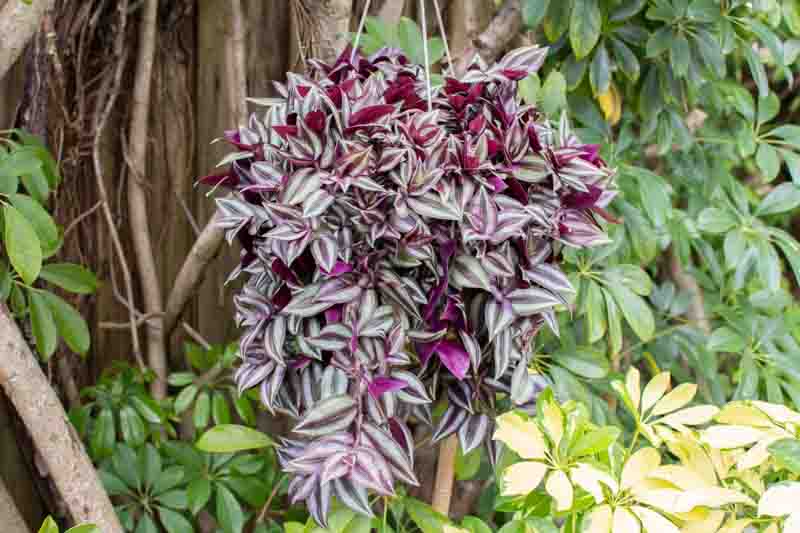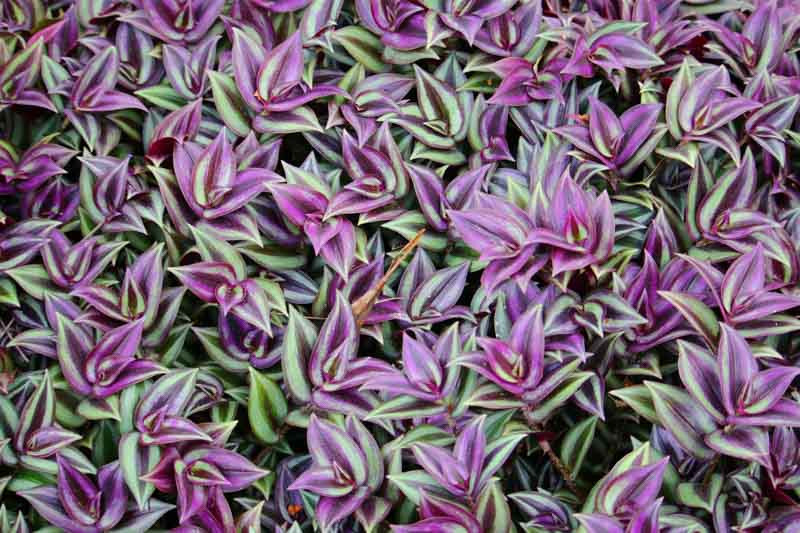Wndering Dude, Wandering Jew, Silver Inch Plant, Tradescantia pendula, Tradescantia tricolor, Tradescantia zebrina pendula
Tradescantia zebrina, commonly known as the Wandering Dude or Inch Plant, is a captivating and popular houseplant known for its striking foliage and ease of care. Formerly known as the Wandering Jew, this plant’s name has evolved due to its controversial nature, with “Wandering Dude” emerging as an alternative. This plant has a rich history and a variety of uses that make it a favorite among gardeners and indoor plant enthusiasts.
The Wandering Dude plant features lush, trailing vines adorned with glossy, oval-shaped leaves. The leaves are a deep green or purple with characteristic silver or white stripes, giving the plant its common name “zebrina” after the zebra-like pattern.
Native: Originally from Mexico and Central America, Tradescantia zebrina has been widely cultivated and naturalized in various tropical and subtropical regions around the world. It belongs to the dayflower or spiderwort family, Commelinaceae.
Plant Type and Habit: The Wandering Dude is a fast-growing, succulent, trailing herbaceous plant, making it ideal for hanging baskets, ground cover, and as an indoor trailing plant.
Size: When grown in hanging baskets or containers, the plant usually stands 6-9 inches tall (15-22 cm) and spreads 2 to 3 feet (60-90 cm) or wider. Planted in the ground, it can spread endlessly, with stems branching or rooting at the nodes, allowing it to sprawl across the terrain.
Flowers: Tiny boat-shaped rosy-purple flowers held in small terminal clusters appear sporadically throughout the year on plants grown in their native habitat, rarely indoors.
Foliage: Tradescantia Zebrina boasts striking foliage with shimmering silver stripes across deep green and rich purple undersides, creating a captivating visual contrast. Its oval-shaped leaves, attached to flexible, trailing stems, make it a popular choice for adding a splash of color and texture to indoor and outdoor spaces. Under prolonged exposure to intense sunlight, the leaf’s variegation diminishes, turning uniformly purple.
Hardiness: This plant is hardy in USDA zones 9-11, where it can be grown outdoors year-round. In cooler climates, it’s commonly grown as a houseplant or annual.
Award: Recipient of the prestigious Award of Garden Merit of the Royal Horticultural Society.
Uses: It’s primarily used as an ornamental plant, suitable for indoor containers, hanging baskets where it will trail gracefully over the edges. It also makes an attractive ground cover in warm winter areas.
Deer and Rabbits: It’s not a primary target for deer and rabbits due to its toxicity, but desperate or curious animals might nibble on it.
Toxicity: Tradescantia zebrina is known to be toxic to pets if ingested, causing gastrointestinal irritation. Repeated or prolonged handling of the plant may cause skin irritation.
Invasiveness: In some regions, particularly in warm, humid climates, it can become invasive if not properly contained, spreading rapidly and potentially outcompeting native plants.
Benefits: Aside from its ornamental value, it’s appreciated for its air-purifying qualities, removing pollutants from indoor environments.

Growing and caring for Tradescantia zebrina is relatively straightforward.
Light: This plant thrives in light shade outdoors but prefers bright light indoors. Move it outside after all danger of frost has passed, slowly getting it used to the sun to avoid sunburn.
Soil: Use a well-draining potting mix. A mixture containing peat moss or coco coir, perlite, and vermiculite works well to maintain moisture while preventing waterlogging.
Water: Keep the soil consistently moist but not waterlogged. Water when the top inch of soil feels dry to the touch. Reduce watering in the winter months.
Temperature and Humidity: Thrives in average room temperatures between 65°F to 75°F (18°C to 24°C). Can tolerate higher humidity levels but grows well in typical household humidity.
Fertilization: Feed with a balanced, water-soluble fertilizer every 4-6 weeks during the growing season (spring through summer). Reduce fertilization in the fall and winter.
Pruning: Regular pruning encourages fuller growth and prevents the plant from becoming too leggy. Pinch back the stems as needed to maintain your desired shape and size.
Repotting: Repot in the spring every 1-2 years or when the plant outgrows its current pot, choosing a pot only slightly larger than the current one to avoid overwatering.
Companion Plants: The Wandering Dude plant excels as a trailing companion in seasonal pots or beneath larger houseplants like hibiscus, plumeria, or ficus trees. It’s also ideal for adding fullness around the base of towering tropicals like cannas, bananas, and elephant ears, whether planted in pots or directly in the soil.
Propagating Tradescantia zebrina is simple and can be done through stem cuttings. Here’s how:

Tradescantia zebrina, while relatively easy to care for, can still encounter a few pests, diseases, and common problems.
Aphids: Small, green, or black insects that suck sap, leading to distorted growth. They can be rinsed off with water or treated with insecticidal soap.
Spider Mites: These tiny pests can cause the foliage to look speckled and faded. Increasing humidity and washing the leaves with water can help; insecticidal soap or neem oil can also be effective.
Mealybugs: These white, cottony pests feed on plant sap, weakening the plant. Remove them manually with a cotton swab dipped in rubbing alcohol or use insecticidal soap.
Root rot: Overwatering is a common cause, leading to mushy roots and wilting plants. Ensure proper drainage and let the soil dry slightly between waterings.
Leaf spot diseases: Fungal infections can cause spots on leaves. Improve air circulation, avoid wetting the leaves when watering, and remove affected foliage.
Fading Leaf Variegation: Insufficient light can cause the vibrant stripes to fade. Provide bright, indirect light to maintain the colorful foliage.
Leggy Growth: This occurs when the plant is not getting enough light, causing it to stretch towards the light source. Pruning back leggy stems encourages bushier growth.
Brown Leaf Tips: Can be a sign of low humidity, over-fertilization, or inconsistent watering. Try to maintain consistent soil moisture and consider using a humidifier if indoor air is dry.
To encourage a bushier growth habit in your Wandering Dude (Tradescantia zebrina), regularly prune stems and pinch tips to encourage branching. Bright, indirect light prevents leggy growth. Fertilize every 4-6 weeks with balanced, water-soluble feed during the growing season for optimal health.
Yes, Tradescantia zebrina is considered toxic to cats (as well as dogs and other pets). The plant contains compounds that can cause irritation to the mouth, stomach, and skin upon ingestion. Symptoms may include drooling, vomiting, and diarrhea. It’s best to keep this plant out of reach of pets.
Tradescantia zebrina is not highly toxic to humans, but it can cause irritation in some individuals. Contact with the plant’s sap may result in skin irritation or rash for those with sensitive skin. Ingestion is not recommended, as it can potentially cause mild gastrointestinal upset. It’s always a good idea to wear gloves when handling the plant if you have sensitive skin or to keep it out of reach of small children who might be tempted to taste it.
Tradescantia zebrina prefers bright, indirect sunlight rather than full sun. Exposure to full sun can fade the leaf colors and cause scorching, especially in hot climates. It thrives under partial shade or filtered light, which helps maintain its vibrant foliage colors.
To maintain the rich purple coloration of Tradescantia zebrina, ensure the plant receives plenty of bright, indirect light. While direct sunlight can damage the leaves, insufficient light can cause the purple hues to fade. A balance of good lighting and some direct morning sun or late afternoon sun can enhance the purple coloration. Also, regular pruning can encourage fuller, more vibrant growth.
Water Tradescantia zebrina when the top inch of soil feels dry to the touch, typically once a week, but this can vary depending on environmental conditions like light, temperature, and humidity. It’s important to provide consistent moisture without overwatering, as the plant does not like to sit in waterlogged soil. Reduce watering in the winter months when the plant’s growth slows down.
| Hardiness |
9 - 11 |
|---|---|
| Heat Zones |
1 - 12 |
| Climate Zones | 1A, 24, H1, H2 |
| Plant Type | Houseplants, Perennials |
| Plant Family | Commelinaceae |
| Genus | Tradescantia |
| Common names | Spiderwort, Wandering Dude |
| Exposure | Full Sun, Partial Sun |
| Season of Interest |
Spring (Early, Mid, Late) Summer (Early, Mid, Late) Fall Winter |
| Height |
6" - 9" (15cm - 23cm) |
| Maintenance | Low |
| Water Needs | Average |
| Soil Type | Loam, Sand |
| Soil pH | Acid, Alkaline, Neutral |
| Soil Drainage | Moist but Well-Drained |
| Characteristics | Plant of Merit, Showy, Evergreen |
| Garden Uses | Ground Covers, Hanging Baskets, Patio And Containers |
| Garden Styles | Mediterranean Garden |
| Hardiness |
9 - 11 |
|---|---|
| Heat Zones |
1 - 12 |
| Climate Zones | 1A, 24, H1, H2 |
| Plant Type | Houseplants, Perennials |
| Plant Family | Commelinaceae |
| Genus | Tradescantia |
| Common names | Spiderwort, Wandering Dude |
| Exposure | Full Sun, Partial Sun |
| Season of Interest |
Spring (Early, Mid, Late) Summer (Early, Mid, Late) Fall Winter |
| Height |
6" - 9" (15cm - 23cm) |
| Maintenance | Low |
| Water Needs | Average |
| Soil Type | Loam, Sand |
| Soil pH | Acid, Alkaline, Neutral |
| Soil Drainage | Moist but Well-Drained |
| Characteristics | Plant of Merit, Showy, Evergreen |
| Garden Uses | Ground Covers, Hanging Baskets, Patio And Containers |
| Garden Styles | Mediterranean Garden |
How many Tradescantia zebrina (Wandering Dude) do I need for my garden?
| Plant | Quantity | |
|---|---|---|
| Tradescantia zebrina (Wandering Dude) | N/A | Buy Plants |
Create a membership account to save your garden designs and to view them on any device.
Becoming a contributing member of Gardenia is easy and can be done in just a few minutes. If you provide us with your name, email address and the payment of a modest $25 annual membership fee, you will become a full member, enabling you to design and save up to 25 of your garden design ideas.
Join now and start creating your dream garden!
Create a membership account to save your garden designs and to view them on any device.
Becoming a contributing member of Gardenia is easy and can be done in just a few minutes. If you provide us with your name, email address and the payment of a modest $25 annual membership fee, you will become a full member, enabling you to design and save up to 25 of your garden design ideas.
Join now and start creating your dream garden!